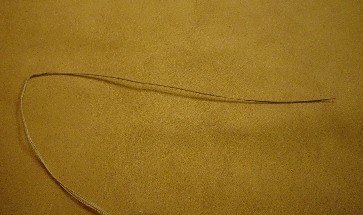 |
I just posted a new tutorial on a Making a Waxed End. Although there are a few sites out there that talk about how to make waxed ends, I thought I’d give my take on it, since it is a rather important skill in crafting raised heels. | |
 |
I just posted a new tutorial on a Making a Waxed End. Although there are a few sites out there that talk about how to make waxed ends, I thought I’d give my take on it, since it is a rather important skill in crafting raised heels. | |
This is really interesting to me for being a technique that is both very different to mine and that I’ve never managed to make work.
At what point in the process do you ply up the threads? It seems from what you’ve written that you’d put a bristle on each end and then ply up the cord?
Thanks.
I think a lot of it has to do with the coad used – I think you need real sticky stuff when you use this technique. In terms of plying the threads, I’m not exactly certain what you mean. Once all 7 threads (which are already individual strands – I use a 1 ply linen thread) are attached to waxed ends on both sides, I will roll each waxed end on my leg and twist it up (twisting the entire stitching cord) so it forms more of a rope than a ribbon and slides through the awl hole better, but that may not be what you’re asking. =)
raisedheels
The confusion here is the thread being made here is to fix onto a nylon or pig/boar bristle. The hole is made with an awl that does not have an eye which the thread is passed through. The tapered thread is whipped onto the bristles. The hole is then made by the awl the thread is then passed through the hole from either side, then pulled tight. Every so many stitches some do a lock stitch either double or single. Just before you pull it tight you pass each end through the loop of the stitch ,then pull tight.
The thread also has a component added to it to make it sticky. A form of tar is added to the mix when making the wax.
\commercial wax is no longer available and most users make their own
Indeed – it’s just as you’ve said it. I mix up my own wax with pine tar (since I can’t get the good pine pitch anymore) which makes it nice and sticky, but not so much that it sticks to everything.
I have run out of natural boars bristle and have had to use the nylon filament type( not good) as thread does not stick so well.I do not have a source to get the boar’s bristle. I note in the text that you are kin enough offer some ( I am willing to pay for them). I doubt that I will be doing much more shoe hand sewing, having started in about 1947 my stash is down to 1 ball of fine white flax which I make up to 4to 7 strands as needed. I have tried the automatic awl( which I made up myself) similar to the Osborne No. 413. but it only gives you a single lock on each thread, whereas on the twin bristle you can performs a double lock stitch on every stitch if you so need.If there is ever a break in the stitching then that way it cannot ” run” or allow stitches either side to loosen. Most important the bristle way give you evenly tensioned stitches
Yes, indeed – in fact, you can check both Etsy and Ebay for “shoemaker boar bristle.” My listing will come up for 7-8″ bristles. And yes, I agree completely – the bristle technique really is superior in every way to stitching awls and such. Plus, it is a historical practice.